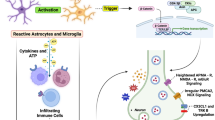Abstract
Sinomenine, an alkaloid originally isolated from the roots of Sinomeniumacutum, is used as a traditional Chinese medicine for rheumatic arthritis. However, little is known about the neuronal mechanisms underlying the analgesic effects of sinomenine in animals with chronic inflammatory pain. In this study, we investigated the persistent inflammatory pain induced by hind paw injection of complete Freund’s adjuvant (CFA) in mice, which was reversed by sinomenine administration. In the anterior cingulate cortex (ACC), a region highly associated with chronic pain processing, the upregulation of GluN2B-containing N-methyl-D-aspartate (NMDA) receptors and Ca2+/calmodulin-dependent protein kinase II, total levels of GluA1, and phosphorylation of GluA1 at Ser831 (p-GluA1-Ser831) were reversed by systemically administrating sinomenine. Furthermore, sinomenine treatment downregulated the mammalian target of rapamycin (mTOR) pathway. Increases in p-mTOR, p-p70S6k, p-S6, and p-4EBP, which were induced by chronic inflammation, were all changed. However, sinomenine did not affect the levels of GluN2A-containing NMDA receptors and p-GluA1-Ser845, as well as the total levels of mTOR, p70S6k, S6, and 4EBP. In conclusion, results indicated that sinomenine reduced the chronic inflammatory pain induced by CFA, at least partially by regulating the GluN2B receptors and mTOR signals in the ACC.





Similar content being viewed by others
Reference
Banke TG, Bowie D, Lee H, Huganir RL, Schousboe A, Traynelis SF (2000) Control of GluR1 AMPA receptor function by cAMP-dependent protein kinase. J Neurosci 20:89–102
Bayer KU, LeBel E, McDonald GL, O’Leary H, Schulman H, De Koninck P (2006) Transition from reversible to persistent binding of CaMKII to postsynaptic sites and NR2B. J Neurosci 26:1164–1174
Cao H, Gao YJ, Ren WH, Li TT, Duan KZ, Cui YH, Cao XH, Zhao ZQ, Ji RR, Zhang YQ (2009) Activation of extracellular signal-regulated kinase in the anterior cingulate cortex contributes to the induction and expression of affective pain. J Neurosci 29:3307–3321
Chaplan SR, Bach FW, Pogrel JW, Chung JM, Yaksh TL (1994) Quantitative assessment of tactile allodynia in the rat paw. J Neurosci Methods 53:55–63
Collingridge GL, Isaac JT, Wang YT (2004) Receptor trafficking and synaptic plasticity. Nat Rev Neurosci 5:952–962
Esteban JA, Shi SH, Wilson C, Nuriya M, Huganir RL, Malinow R (2003) PKA phosphorylation of AMPA receptor subunits controls synaptic trafficking underlying plasticity. Nat Neurosci 6:136–143
Gao T, Hao J, Wiesenfeld-Hallin Z, Wang DQ, XJ X (2013) Analgesic effect of sinomenine in rodents after inflammation and nerve injury. Eur J Pharmacol 721:5–11
Geranton SM, Jimenez-Diaz L, Torsney C, Tochiki KK, Stuart SA, Leith JL, Lumb BM, Hunt SP (2009) A rapamycin-sensitive signaling pathway is essential for the full expression of persistent pain states. J Neurosci 29:15017–15027
Guo YY, Liu SB, Cui GB, Ma L, Feng B, Xing JH, Yang Q, Li XQ, YM W, Xiong LZ, Zhang W, Zhao MG (2012) Acute stress induces down-regulation of large-conductance Ca2 + −activated potassium channels in the lateral amygdala. J Physiol 590:875–886
Hargreaves K, Dubner R, Brown F, Flores C, Joris J (1988) A new and sensitive method for measuring thermal nociception in cutaneous hyperalgesia. Pain 32:77–88
Hay N, Sonenberg N (2004) Upstream and downstream of mTOR. Genes Dev 18:1926–1945
Hayashi Y, Shi SH, Esteban JA, Piccini A, Poncer JC, Malinow R (2000) Driving AMPA receptors into synapses by LTP and CaMKII: requirement for GluR1 and PDZ domain interaction. Science 287:2262–2267
Hollmann M, Heinemann S (1994) Cloned glutamate receptors. Annu Rev Neurosci 17:31–108
Jaworski J, Sheng M (2006) The growing role of mTOR in neuronal development and plasticity. Mol Neurobiol 34:205–219
Kang SJ, Kwak C, Lee J, Sim SE, Shim J, Choi T, Collingridge GL, Zhuo M, Kaang BK (2015) Bidirectional modulation of hyperalgesia via the specific control of excitatory and inhibitory neuronal activity in the ACC. Mol Brain 8:81
Kessels HW, Malinow R (2009) Synaptic AMPA receptor plasticity and behavior. Neuron 61:340–350
Liang L, Tao B, Fan L, Yaster M, Zhang Y, Tao YX (2013) mTOR and its downstream pathway are activated in the dorsal root ganglion and spinal cord after peripheral inflammation, but not after nerve injury. Brain Res 1513:17–25
Luo F, Yang C, Chen Y, Shukla P, Tang L, Wang LLX, Wang ZJ (2008) Reversal of chronic inflammatory pain by acute inhibition of Ca2+/calmodulin-dependent protein kinase II. J Pharm and Exp Ther 325:267–275
Luo C, Zhang YL, Luo W, Zhou FH, Li CQ, JM X, Dai RP (2015) Differential effects of general anesthetics on anxiety-like behavior in formalin-induced pain: involvement of ERK activation in the anterior cingulate cortex. Psychopharmacology 232:4433–4444
Monyer H, Burnashev N, Laurie DJ, Sakmann B, Seeburg PH (1994) Developmental and regional expression in the rat brain and functional properties of four NMDA receptors. Neuron 12:529–540
Morishita W, Marie H, Malenka RC (2005) Distinct triggering and expression mechanisms underlie LTD of AMPA and NMDA synaptic responses. Nat Neurosci 8:1043–1050
Norsted Gregory E, Codeluppi S, Gregory JA, Steinauer J, Svensson CI (2010) Mammalian target of rapamycin in spinal cord neurons mediates hypersensitivity induced by peripheral inflammation. Neuroscience 169:1392–1402
O’Connor AB (2009) Neuropathic pain: quality-of-life impact, costs and cost effectiveness of therapy. PharmacoEconomics 27:95–112
Price DD (2000) Psychological and neural mechanisms of the affective dimension of pain. Science 288:1769–1772
Qiu S, Chen T, Koga K, Guo YY, Xu H, Song Q, Wang JJ, Descalzi G, Kaang BK, Luo JH, Zhuo M, Zhao MG (2013) An increase in synaptic NMDA receptors in the insular cortex contributes to neuropathic pain. Sci Signal 6:ra34
Singer T, Seymour B, O’Doherty J, Kaube H, Dolan RJ, Frith CD (2004) Empathy for pain involves the affective but not sensory components of pain. Science 303:1157–1162
Swiech L, Perycz M, Malik A, Jaworski J (2008) Role of mTOR in physiology and pathology of the nervous system. Biochim Biophys Acta 1784:116–132
Tal M (1999) A role for inflammation in chronic pain. Curr Rev Pain 3:440–446
Talbot JD, Marrett S, Evans AC, Meyer E, Bushnell MC, Duncan GH (1991) Multiple representations of pain in human cerebral cortex. Science 251:1355–1358
Tian Z, Wang Y, Zhang N, Guo YY, Feng B, Liu SB, Zhao MG (2013) Estrogen receptor GPR30 exerts anxiolytic effects by maintaining the balance between GABAergic and glutamatergic transmission in the basolateral amygdala of ovariectomized mice after stress. Psychoneuroendocrinology 38:2218–2233
Wang H, Dai Y, Fukuoka T, Yamanaka H, Obata K, Tokunaga A, Noguchi K (2004) Enhancement of stimulation-induced ERK activation in the spinal dorsal horn and gracile nucleus neurons in rats with peripheral nerve injury. Eur J Neurosci 19:884–890
Weston CS (2012) Another major function of the anterior cingulate cortex: the representation of requirements. Neurosci Biobehav Rev 36:90–110
Wu LJ, Toyoda H, Zhao MG, Lee YS, Tang J, Ko SW, Jia YH, Shum FW, Zerbinatti CV, Bu G, Wei F, TL X, Muglia LJ, Chen ZF, Auberson YP, Kaang BK, Zhuo M (2005) Upregulation of forebrain NMDA NR2B receptors contributes to behavioral sensitization after inflammation. J Neurosci 25:11107–11116
Xu M, Liu L, Qi C, Deng B, Cai X (2008) Sinomenine versus NSAIDs for the treatment of rheumatoid arthritis: a systematic review and meta-analysis. Planta Med 74:1423–1429
Xu Q, Fitzsimmons B, Steinauer J, O’Neill A, Newton AC, Hua XY, Yaksh TL (2011) Spinal phosphinositide 3-kinase-Akt-mammalian target of rapamycin signaling cascades in inflammation-induced hyperalgesia. J Neurosci 31:2113–2124
Yamasaki H (1976) Pharmacology of sinomenine, an anti-rheumatic alkaloid from Sinomenium acutum. Acta Med Okayama 30:1–20
Yang HB, Yang X, Cao J, Li S, Liu YN, Suo ZW, Cui HB, Guo Z, XD H (2011) cAMP-dependent protein kinase activated Fyn in spinal dorsal horn to regulate NMDA receptor function during inflammatory pain. J Neurochem 116:93–104
Yin X, Takei Y, Kido MA, Hirokawa N (2011) Molecular motor KIF17 is fundamental for memory and learning via differential support of synaptic NR2A/2B levels. Neuron 70:310–325
Yu S, Xu L, Wei PK, Qin ZF, Li J, Peng HD (2008) Study on analgesic effect of traditional Chinese medicine. Chin J Integr Med 14:151–156
Zhao MG, Toyoda H, Lee YS, LJ W, Ko SW, Zhang XH, Jia Y, Shum F, Xu H, Li BM, Kaang BK, Zhuo M (2005) Roles of NMDA NR2B subtype receptor in prefrontal long-term potentiation and contextual fear memory. Neuron 47:859–872
Zhao MG, Ko SW, LJ W, Toyoda H, Xu H, Quan J, Li J, Jia Y, Ren M, ZC X, Zhuo M (2006) Enhanced presynaptic neurotransmitter release in the anterior cingulate cortex of mice with chronic pain. J Neurosci 26:8923–8930
Zhuo M (2002) Glutamate receptors and persistent pain: targeting forebrain NR2B subunits. Drug Discov Today 7:259–267
Zou X, Lin Q, Willis WD (2000) Enhanced phosphorylation of NMDA receptor 1 subunits in spinal cord dorsal horn and spinothalamic tract neurons after intradermal injection of capsaicin in rats. J Neurosci 20:6989–6997
Acknowledgments
This work was supported by the National Natural Science Foundation of China No. 81325022, and Clinical Science and Technology Project Funding in Jiangsu Province (No. BL2012002).
Conflicts of interest
The authors declare that they have no conflict of interest.
Author information
Authors and Affiliations
Corresponding authors
Additional information
Shuo Li, Jing Han, Dong-sheng Wang contribute equally to this work.
Rights and permissions
About this article
Cite this article
Li, S., Han, J., Wang, Ds. et al. Sinomenine attenuates chronic inflammatory pain in mice. Metab Brain Dis 32, 211–219 (2017). https://doi.org/10.1007/s11011-016-9889-8
Received:
Accepted:
Published:
Issue Date:
DOI: https://doi.org/10.1007/s11011-016-9889-8




